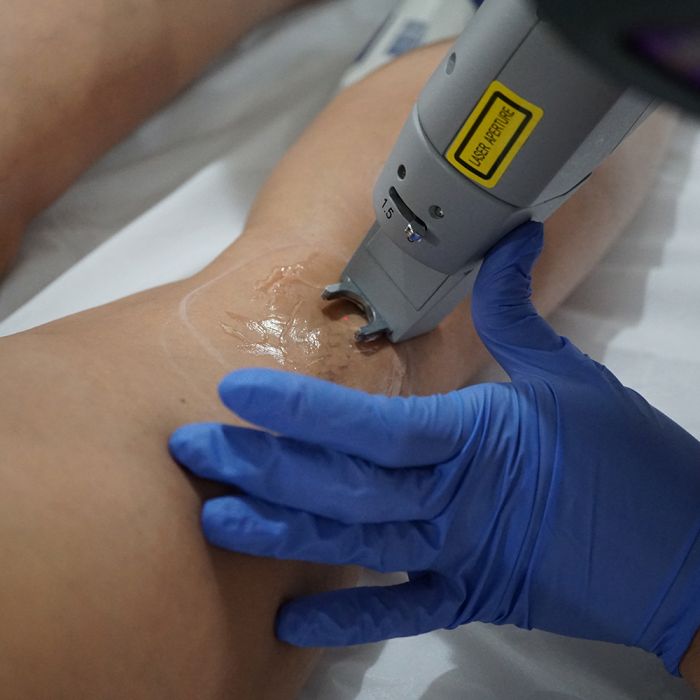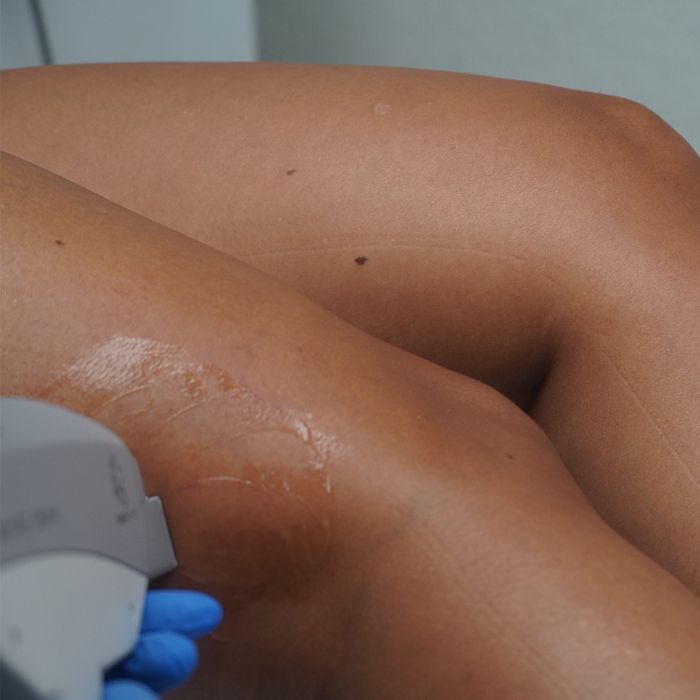Spider Veins (Laser Sclerotherapy)
Laser treatment for spider veins is a quick, effective, and non-invasive procedure that uses a focused beam of light to heat and destroy affected veins.
Laser treatment for spider veins is a quick, effective, and non-invasive procedure that uses a focused beam of light to heat and destroy affected veins. When laser energy is applied to the treatment area, it targets the pigment in the blood and warms the vessel without damaging the skin or surrounding tissues. Overtime – usually, in four to six weeks after treatment – the vein is reabsorbed by the body and disappears. Blood gets rerouted to healthier veins.
Choosing Sclerotherapy vs. Laser Vein Treatment
If you are unhappy with unsightly spider veins and have researched the pros and cons of sclerotherapy vs. laser therapy, you’re one step closer to making an informed decision about the treatment that is right for you.
Sclerotherapy may be the better choice if you have a low pain threshold or if your skin type is not compatible with the laser used during laser vein therapy. Laser treatment for spider veins may be the preferred option if you have an aversion to needles or the medications used during sclerotherapy, or if the vessels that need treatment are too small to be injected. The best choice of treatment may also depend on the size and location of your veins.
In some cases, combining both spider vein and varicose vein treatment options is the best course of action to eradicate spider veins for good. An integrated treatment plan may be recommended after evaluating the size, location and the number of visible vessels present during a consultation.
Spider veins are dilated blood vessels on the skin’s surface. They appear red or blue, and may be connected in web or branched pattern, or short, individual lines.
Spider veins are a reality for millions of people. Luckily, using saline injections can treat those unattractive veins.
When the valves in your veins weaken or blood flow circulation is weak, this causes the blood that normally flows toward your heart to collect in the valve areas. The results of this are spider veins, which appear as blue or red spiders just below the skin’s surface, and can appear in the face as well as the legs. Many factors can cause spider veins including:
- Blood flow during pregnancy
- Exposure to the sun on fair skin
- Heredity
- Obesity
- Standing for long periods of time
While it is possible to avoid most causes of spider veins, we often see patients for whom professional treatment is unavoidable.
Benefits
Sclerotherapy is the “gold standard” and is preferred over laser for eliminating large spider veins (telangiectasiae), reticular (blue veins) and smaller varicose leg veins (up to the size of a pencil).
Unlike a laser, the sclero solution also closes the “feeder veins” under the skin that are causing the spider veins to form, thereby making a recurrence of the spider veins in the treated area less likely.
How Is Laser Vein Treatment Performed?
During laser spider vein treatment, you will be given a pair of goggles that protect your eyes from the intense laser light. Next, we will apply a cooling gel to the area being treated. The laser will be placed against the skin over the spider veins. You may feel some uncomfortable sensations as the laser fires; patients often say it feels like a rubber band snapping against their skin. Ice may be used to increase your comfort during the procedure. Laser vein treatment requires no downtime, though it’s common to experience some inflammation and redness in the treated area, and compression garments should be worn for some time after your appointment.
How Many Laser Vein Treatments Are Required?
Depending on the number, color and size of the veins being treated, more than one session may be required to achieve an optimal outcome. Appointments will be scheduled approximately four weeks apart for the duration of your treatment.
Am I a Good Candidate for Laser Vein Treatment?
Laser vein therapy can be one of the most effective spider vein treatment options for a variety of patients. The ideal patient is in good overall health, does not smoke and has realistic expectations for the procedure. It may also be the best choice if you are allergic to the chemicals used in sclerotherapy, if you are afraid of needles or if your spider veins are too small to be injected. You may not be a candidate if you have certain medical conditions, if you are pregnant, have tattoos in the treatment area or if you take certain medications.
What Is Sclerotherapy?
Sclerotherapy is a minimally invasive spider vein treatment that works by delivering a sclerosing agent into the troublesome vessel via injection. When injected, the solution irritates the inner lining of the vein, causing it to seal closed. The vessel eventually becomes scar tissue and disappears as the body absorbs it.
How Is Sclerotherapy Performed?
After cleansing the treatment area using an antiseptic solution, your sclerotherapist will use a small needle to inject one of two FDA-approved sclerosing solutions directly into the vessel being treated. Discomfort during the procedure is minimal, and no anesthesia is required. You may feel a slight prick, and a mild burning sensation as the needle is placed, and the solution is injected. After treatment, you may experience short-lived itching, bruising or burning in the treatment area. There is no downtime after sclerotherapy.
How Many Sclerotherapy Treatments Are Required?
Most patients require between three and five sclerotherapy treatments to achieve optimal results. Your treatment plan will be personalized based on the size of the area being treated and your individual goals.
Who Is A Candidate for Sclerotherapy?
If you have unsightly veins but are otherwise healthy, have reasonable expectations and are not afraid of needles, sclerotherapy may be your best treatment for spider veins. Sclerotherapy may not be right for you if you are pregnant, extremely sedentary, on iron supplements, allergic to the sclerosing agent or over the age of 75. Certain medical conditions, such as a clotting disorder or underlying lung disease, may also make sclerotherapy inappropriate for you.
Treatment Type
Sclerotherapy
Treatment Problem or Condition
Spider Veins
Brand
None
Multipe treatments may be required depending on the severity of the condition and the individual response of the patient.



